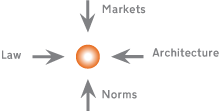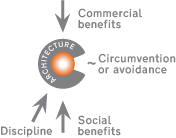Lawrence Lessig, currently of Stanford Law School, has been at the forefront of much recent and current debate on intellectual property and how the internet is constructed and regulated. His books, Code, and Other Laws of Cyberspace [29], The Future of Ideas [51] and more recently Free Culture [26] have established the issues of online freedom, the Creative Commons and the digital rights debate within an academic framework.
Specifically relevant to this paper is Lessig’s chapter, ‘What things regulate,’ in Code, and Other Laws of Cyberspace, in which the idea is introduced of four constraints, or ‘regulators’ on an individual, or an activity or behaviour:

“Four constraints regulate this pathetic dot–the law, social norms, the market, and architecture–and the ‘regulation’ of this dot is the sum of these four constraints… The constraints are distinct, yet they are plainly interdependent. Each can support or oppose the others. Technologies can undermine norms and laws; they can also support them [emphasis added]” [50].
In a sense, this site is investigating how the ‘architecture’ regulator can be (and is being) extended–through the incorporation of architectures of control into products–so that its scope encompasses the aims of the market (commercial benefit) and possibly the law (disciplinary architecture) and social norms (social benefit), although the mapping is clearly not exactly one-to-one:

A possible modification to Lessig’s diagram to illustrate architectures of control
Lessig’s architecture is applied to the internet in terms of the software that governs the way people and machines can interact; his argument is that governments (or companies) have a range of methods beyond the law itself through which they can regulate consumers’ behaviour, and that the public should wake up to this. This site aims to demonstrate some manifestations of that regulation in the context of product design.
Previous: Artefacts & politics | Next: Control & networks